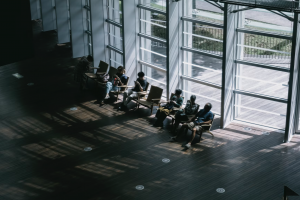An old lady is sitting by herself in an empty train compartment when a group of three young guys enter loudly. After spotting the old lady they provocatively ask her: Aren’t you afraid of traveling alone at your age? To which the old lady hesitates for a moment and answers: What do you mean alone? I’ve got you guys.
– An anecdote from which I have forgotten the source
At the turn of the century, political scientist Robert Putnam already discussed the breakdown of social capital in America since the 1950’s in his famous Bowling Alone. Putnam discussed ways in which people disengaged from community involvement, concluding (one of the) the main cause(s) was technology “individualizing” people’s leisure time via television and the Internet. 25 years later, it’s safe to say that his book was in many ways predictive of a trend that is defining much of the Western world; a shift to a more anti-social world.
When we look at current trends on our social connections, things are not looking good. A great analysis in the Financial Times found that between 2010 and 2023, there has been a sharp increase in the time we spent alone. Especially young people exhibit social behavior that is typically not matching with their age group; “people in their teens and twenties now hang out about as much as someone 10 years older than them did in the past.”

The privatization of leisure
Young people are instead opting for more lone activities like gaming, social media or relaxing, at the expense of activities like socialising, watching movies with others or going to parties. The latter fall under what Liana C. Sayer, a sociologist at the University of Maryland, calls ‘sedentary leisure’. And this category of sedentary leisure is associated with negative physical and mental health, whereas well-being is higher among adults who spend larger shares of leisure with others.

Our social DNA
People are inherently social creatures — this can barely be overstated. When we lack social connections it affects both our mental wellbeing and our physical and cognitive health.
Data from more than 580,000 adults and found that social isolation increases the risk of premature death from every cause. It increases our risk of depression, poor sleep quality, impaired executive function, accelerated cognitive decline, poor cardiovascular function and impaired immunity at every stage of life.
Lonely people are also more vulnerable to extremist views, more vulnerable to scams, more often absent from work, and perform worse at their job. They score lower in interpersonal trust and reduced political efficacy (the extent to which a person thinks their voice counts in politics). Loneliness compromises decision making in older adults (leading them to make questionable career decisions to combat their loneliness). Moreover, lonely individuals tend to be more inclined to engage in risk-taking behaviours, potentially impacting community safety.
As someone that has looked into research on social connection and how it affects us for almost a decade, I can honestly tell you: I can not think of any social phenomenon that impacts us more negatively, across the board, than loneliness and social isolation. Even smoking is arguably ‘healthier’ to a certain degree (up to 15 cigarettes a day apparently).
Another important note is that people that live in solitude or social isolation do not necessarily feel lonely. Yet can still experience the negative social and health effects that the lack of social interaction brings. The other way around, lonely people are not necessarily isolated, it’s very possible to be surrounded by close friends and family – and still feel alone.
Now…I’m sure you knew most of this already, and I don’t want to bore you with a comprehensive list of why it sucks to be or feel alone — I just want to stress: when society turns more inward… bad things happen. It messes with our health, our happiness, our communities and our social fabric. It threatens what makes us human.
Voluntary solitude
What is especially remarkable about the decrease of our social fabric is, as some researchers noted, it’s by choice. It’s not that we cannot seem to make friends, or have less of them than previous generations. Not that we have no one to talk to. Not even that we’re all too busy to mingle. It’s in many ways because we choose to spend more time alone.
A great in-depth essay by Derek Thompson elaborates on the surprising voluntary element of our anti-social modern behavior:
“Self-imposed solitude might just be the most important social fact of the 21st century in America. Perhaps unsurprisingly, many observers have reduced this phenomenon to the topic of loneliness.
(…)
But solitude and loneliness are not one and the same. “It is actually a very healthy emotional response to feel some loneliness,” the NYU sociologist Eric Klinenberg told me. “That cue is the thing that pushes you off the couch and into face-to-face interaction.” The real problem here, the nature of America’s social crisis, is that most Americans don’t seem to be reacting to the biological cue to spend more time with other people. Their solitude levels are surging while many measures of loneliness are actually flat or dropping.
Even though some of the sources I cite American shifts, the relevant elements in others parts of the world, like the Netherlands are similar: a large scale adoption of comfort and convenience, less time spent socialising per week, and around 57 per cent of young Europeans aged from 18 to 35 report feeling moderately or strongly lonely.
A frictionless life
We currently reside in a strange position where we voluntarily choose to refrain from socializing, even though we intuitively feel something is missing. And it’s negatively impacting our health and happiness. We know we shouldn’t (always) pick comfort, but we do. And it’s easy to understand why; we are surrounded by endless comfort and instant sources of dopamine. Traditional third spaces like community centers, churches, or cinemas are replaced by solitary entertainment.
“In the 1930s, (…) the typical American went to the movies several times a month. Film was a necessarily collective experience, something enjoyed with friends and in the company of strangers. But technology has turned film into a home delivery system. Today, the typical American adult buys about three movie tickets a year—and watches almost 19 hours of television, the equivalent of roughly eight movies, on a weekly basis.”
You might note that nowadays it is possible to watch movies in the comfort of your home, compared to the 30’s, and you would be right. But this is true for almost anything today: whether it’s food delivery, social media, television, porn; they all compress significant parts of the traditional ‘outer’ world and replicate them into our home. And what they all have in common is: they water down — or even remove — the social part in favour of comfort and convenience. Today, it is easier to avoid others than ever before in history.
Brands can contribute
Brands are complicit in creating an anti-social world. This has obviously been no conscious effort, but, by removing friction in every aspect of our lives, we avoid the inefficient social interactions that we would normally have with others. And as described above, these social interactions had tremendous benefits.
What is surprising, however, is the lack of urgency and awareness regarding this anti-social development. Governments and businesses have been working for years to tackle climate change, estimating it (rightfully) as an utmost priority for the world. Combatting the breakdown of our social fabric, on the other hand, generally lacks this kind of urgency in both brand strategy and national policy. But just because the effects are not as visible as melting ice caps and burning forests, it doesn’t mean the effects on people are not serious.
The urgency should be much, much higher. The fading of social fabric is about public health, both physical and mental, it’s about trust in our institutions and about mitigating polarisation. The ’S’ in ESG poses a genuine and significant opportunity to improve human wellbeing.
But on top of that, it also poses a great opportunity to be(come) meaningful and distinct in the lives of your customers. There are many ways in which brands from different industries can contribute to stronger social ties. It could be about reversing the trend of fading social capital and rebuilding a strong and resilient one instead. What attractive alternative can you contribute to, to get people outside and mingle with others, instead of staying alone, indoors?
For example by stimulating third spaces where people can casually meet up after work or school. For large beer brands (or municipal fractions) to conserve and cherish the oldest pubs for their historic social capital. For travel organisations to bring strangers together on amazing adventures. For public transportation brands (or supermarkets) by returning a little bit of social friction in public life by stimulating small talk. By active brands to help people find motivation to get out there. By sport brands to bring together communities based on hobbies. By lifestyle brands to help people break the ice and create vibrant public spaces where young people can hang out. By healthcare insurers to promote social behaviour. There are countless ways in which any brand can credibly contribute to social cohesion.

Perhaps you’re afraid that forcing social interaction on customers would backfire. Research, however, shows that people feel much better after talking to a stranger, despite thinking it would make them uncomfortable. Participants were asked in an experiment to either talk to a stranger on the train or travel without talking to anyone. Beforehand, participants predicted it would make them happier to travel in solitude, but results showed participants who chatted with someone else were actually significantly happier afterwards.
The conclusion is quite clear: more social interaction makes us happier, we just think it won’t. On top of that, it makes our lives more healthy and meaningful, it boosts our longevity and stimulates a well-functioning democracy. And as a brand you can be part of the surprising, spontaneous and positive social experiences that contribute to all of the above. So for the love of god — provide some social friction.

Author
Douwe Knijff
Share the signal.

Author
Aljan de Boer











